
Unteroffizier Fritz Ruhlandt was a rock star. In September of 1940 Uffz Ruhlandt was a command pilot flying the cutting edge Junkers Ju 88A-1 Schnellbomber. A veteran of the campaigns in both Poland and France, he now flew against the English during the Battle of Britain. His squadron, Kampfgeschwader 77, was the very tip of the spear. Amidst a veritable sea of committed, capable, competitive pilots, Uffz Ruhlandt was as good as it got.

The Schnellbomber was so named because it was fast. The Ju 88 with its twin Junkers Jumo 211J-1 1,340 hp engines could cruise at 230 mph, holding its own with the fighters of its day. In a dive, it could outpace even the vaunted Spitfire. To be commanding this plane at this time at the vanguard of the most powerful air army in history Uffz Ruhlandt was part of an undeniably elite fraternity.

The effectiveness of a multi-engine combat aircraft like the Ju 88 was much more than a simple reflection of the rarefied skills of its pilot. Ruhlandt’s crew formed an integrated team. Feldwebel Gotthard Richter was the bomb aimer, Uffz Erwin Richter (apparently no relation) was the radio operator, and Flieger Jakob Reiner was the gunner. The mission to bomb strategic targets in London on September 27th was their first combat operation together.

Their sleek, deadly plane was but two weeks out of the factory and reflected the state of the art. In addition to being exceptionally fast, the Ju 88 was also versatile. The Schnellbomber served as a bomber, night fighter, dive bomber, reconnaissance platform, heavy fighter, and torpedo bomber before the war finally ground to a bloody halt. The Germans ultimately produced more than 15,000 copies. Ruhlandt and his crew had christened their brand new bird of prey the “Eule” or “Owl.”
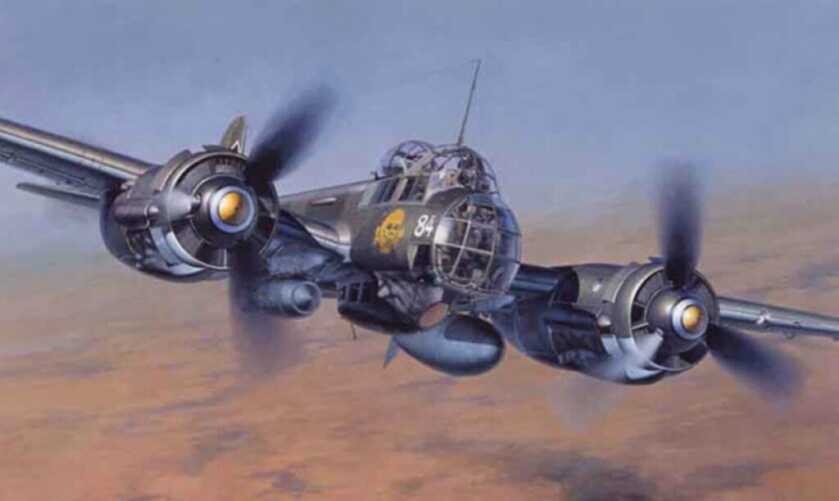
What really made the Owl special was its classified BZA (Bomben Ziel Anlage or “Bomb Target System”). The BZA was an analog computer designed to assist in performing the delicate but critical maneuvers necessary for a successful dive bombing mission. British Intelligence desperately wanted a BZA of their own.
The Mission

Nine days prior over London III Gruppe that included KG77, lost nine of its Ju 88’s in a single mission. On the 27th Uffz Ruhlandt’s Owl was part of a 300-plane assault again destined for London. Fully twenty RAF squadrons of Hurricanes and Spitfires rose in opposition. The combat that followed stretched across a full two hours, an absolute eternity in an all-out air war.

Ruhlandt’s plane lost an engine to flak over the South Bank of the Thames. This dropped the plane’s maximum speed to a lumbering 155 mph, making it easy meat for the Spits. The Eule fell out of formation, and the pursing RAF fighters proceeded to chew it to pieces.

Having descended to a dangerously low level the Spitfires raked the canopy with .303 machinegun fire and shot out the remaining engine. Now a glider, the Ju 88 touched down in Graveney Marsh, took a sickening bounce, and then slid some 300 yards. The dying plane shed its props before coming to an inglorious stop about a quarter-mile from the Sportsman Inn, a local landmark built in 1642.
The Players

The British justifiably feared a pending seaborne invasion, so the thin defensive units available were spread throughout a series of strongpoints scattered across the area. The 1st Bn London Irish Rifles had responsibility for the Graveney Marsh sector. Under the immediate command of War Substantive Lieutenant (Temporary Captain) John Cantopher, 10 men from the LIR along with a LT Yeardley and SGT Allworth made their way to the crash site, albeit by different routes.
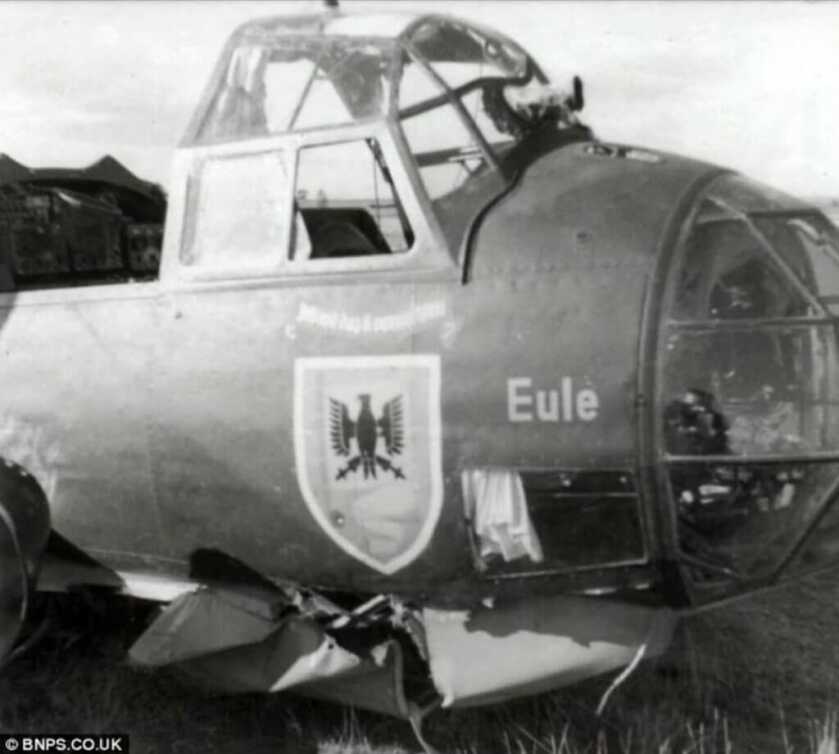
Ruhlandt now had but a single mission. Britain being an island, successful escape and evasion back to friendly German forces was impossible. Using the tools at hand the young German pilot now had to destroy his state-of-the-art combat plane lest it fall into the hands of the British and divulge its many secrets. To assist him in this mission, Uffz Ruhlandt had a Sprengbuchse 24.
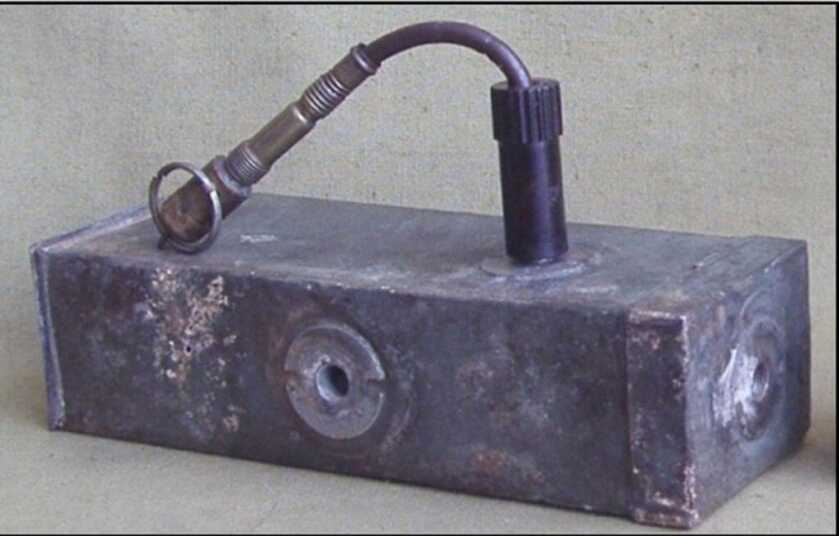
The Sprengbuchse 24 was a 1kg TNT charge affixed to the end of a six-foot time fuse. Once detonated within the cockpit of the Owl the Sprengbuchse 24 would obliterate anything useful. The Luftwaffe fliers just had to hold off the thirteen approaching British Tommies for 3.5 minutes until the charge detonated.

Radio Operator SGT Erwin Richter had taken glass splinters in his eyes from the Spitfire attacks earlier, but everyone else among the crew remained prickly. The Germans harvested a pair of defensive machineguns from the wreck as well as an MP40 submachine gun. The MP40 along with a brace of 32-round magazines was part of the plane’s survival kit. When the British Infantry got within range of the crash site somebody started firing.
The German Guns
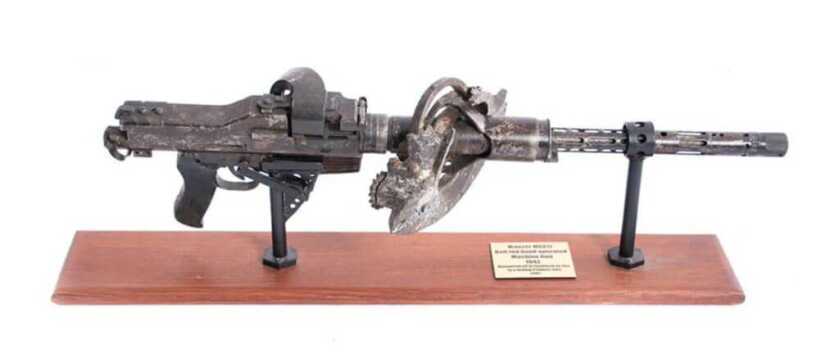
I have found reference to this particular Ju 88’s defensive weapons being either MG15 or MG 81 7.92x57mm machineguns. The MG81 is a belt-fed design, while the MG15 fed from a detachable 75-round saddle drum magazine. The basic load for a typical MG15 position was eleven magazines. The MG 81 replaced the MG15 in operational service at the end of 1940. As a result, the balance of probability the guns on the Owl that day were MG15’s.

The MG15 was a strikingly simple design. Though I have never had the pleasure of firing a specimen, I have detail stripped a copy to study its mechanism. The open-bolt, recoil-operated weapon looks and behaves like a giant open-bolt rifle-caliber submachine gun. The MG15 featured a 24-inch barrel and weighed 27 lbs fully loaded.
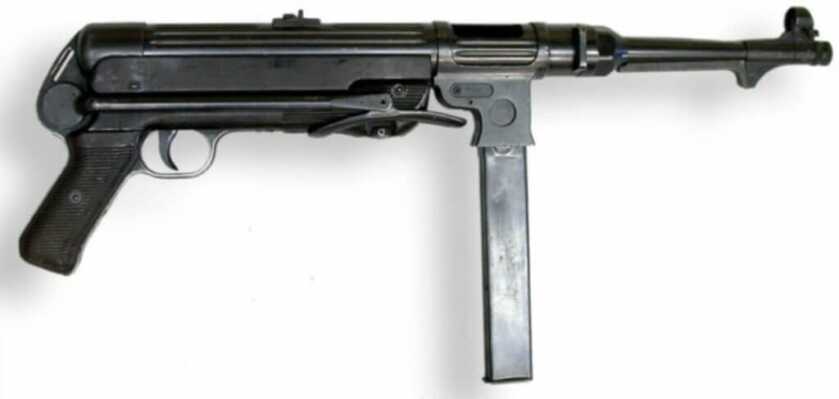
The Maschinenpistole 40 was a direct evolutionary offshoot of the previous MP38. Designed in 1938 by the esteemed small arms designer Heinrich Vollmer, the MP40 was the first mass-produced SMG that featured pressed steel construction and synthetic furniture. While the previous MP38 was built around a machined tubular steel receiver, that of the MP40 was formed from sheet steel on industrial presses.
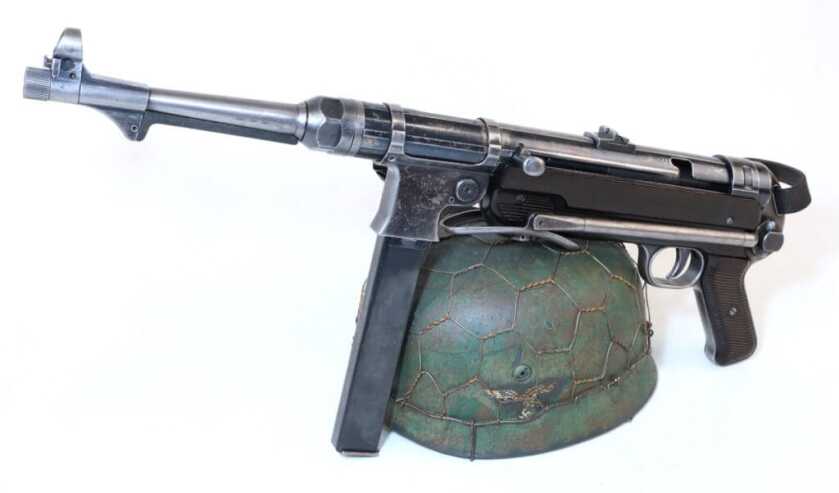
The MP40 changed the way the world made weapons. With synthetic Bakelite furniture and predominantly pressed-steel components, the MP40 set the foundation for countless military weapons to come. Just over 1 million copies of the MP40 rolled off the lines before it was supplanted by the MP44.
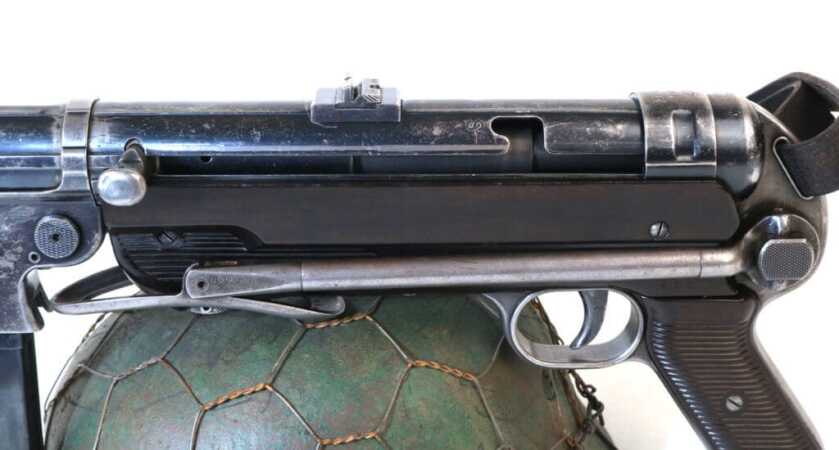
Bakelite is a thermosetting phenol formaldehyde resin called polyoxybenzylmethylenglycolanhydride. Developed by a Belgian-American chemist named Leo Baekeland in Yonkers, NY, in 1907, Bakelite was first used on such stuff as electrical insulators, toys, pipestems, and kitchenware. Bakelite pioneered the use of advanced synthetic materials in myriad guns produced around the world today.
British Ordnance
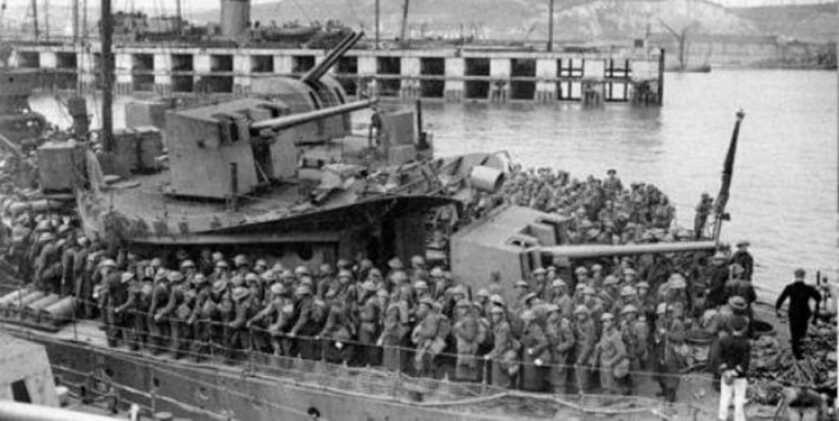
The evacuation three months earlier miraculously preserved the bulk of the British Army from obliteration on the desolate French beaches at Dunkirk. However, most of the surviving Tommies made it across the channel without their weapons. As a result, the thirteen British troops from the 1st Bn LIR were armed with WW1-era arms. This meant the Short Magazine Lee Enfield rifle and the Webley Mk VI revolver.
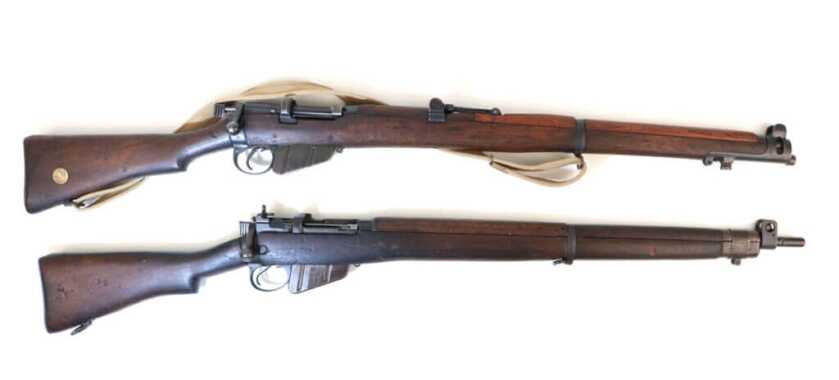
British troops affectionately referred to the SMLE as the “Smelly.” Derived from the previous black powder Lee-Metford rifle, the SMLE was arguably the most advanced Infantry rifle of the First World War. The SMLE fired the standard British rimmed .303-inch cartridge. More than 17 million copies were produced.

The short bolt throw of the SMLE combined with the fact that the action cocked on closing made the SMLE exceptionally fast. In 1914 a British musketry instructor named Oxnall set the world record for rapid fire from a bolt-action rifle by landing 38 rounds inside a 12-inch circle at 300 yards in 60 seconds. This record still stands today. Wow.
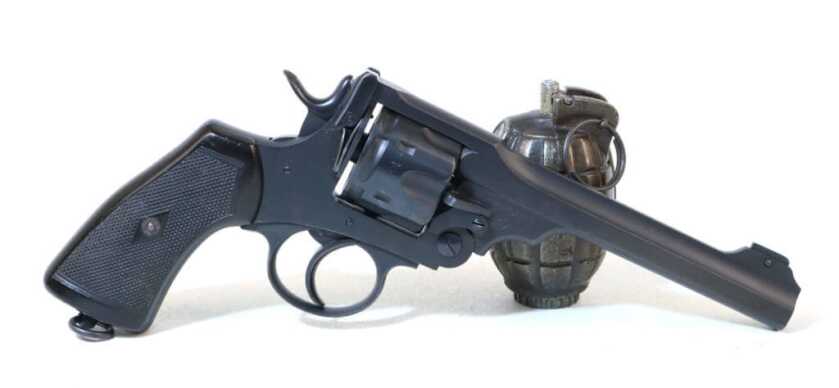
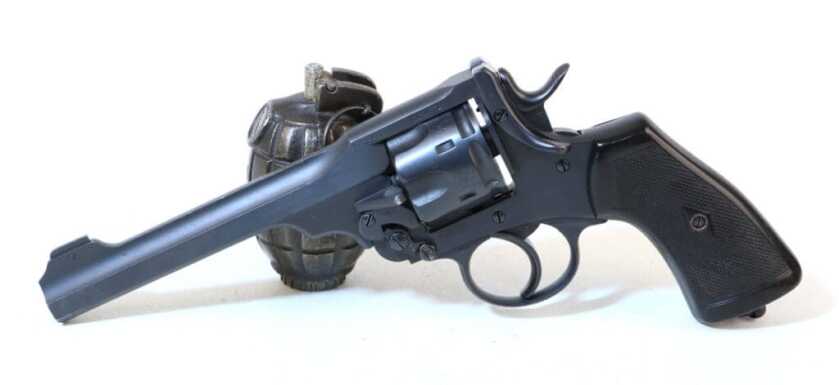
The Webley MK VI was a heavy .455-caliber top-break revolver produced from 1915 through 1923. A SA/DA design, the MK VI featured a six-inch barrel and weighed some 2.4 pounds empty. The top-break design yielded an impressive rate of fire for its day.
The Rest of the Story
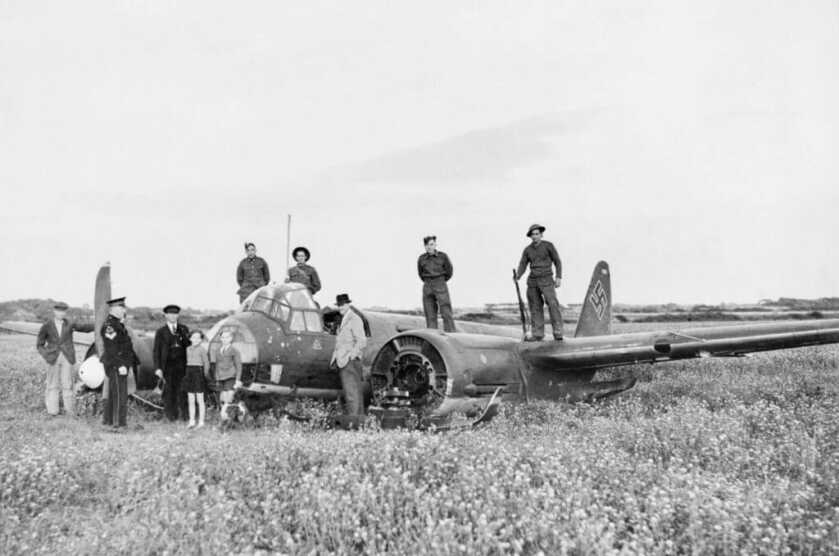
The Battle of Graveney Marsh didn’t actually last very long. Uffz Ruhlandt promptly caught a round in the foot. The Germans waved a white flag and explained that their machinegun fire had been directed into the cockpit of their aircraft in an attempt to destroy it. They later claimed not to have even seen the approaching British unit until they had been fired upon. British LT Cantopher retrieved what he believed to be the Sprengbuchse 24 and rendered it safe by tossing the thing into a nearby drainage ditch.

The Brits marched the captured Germans back to the Sportsman and treated them to pints of British beer in return for the insignia off of their uniforms. Uffz Ruhlandt and his crew spent the rest of the war in a POW camp, LT Cantopher was awarded the George Medal for bravery in the last armed ground conflict of WW2 fought on British soil, and British Intelligence quietly retired to study their intact and operational top-secret BZA bomb aiming computer.
Special thanks to www.worldwarsupply.com for the cool replica helmets used in our photos.



Perhaps I misunderstood the post below. However, if the implication is that the British bombed Belfast and then claimed it was the Germans that just couldn’t happen. That couldn’t happen for the same reason there are no secret black government helicopters scurrying about the US keeping tabs on us. That can’t happen because governments really suck at keeping big things secret. If there were black helicopters there would be some 23-year-old dude maintaining them and he would have a girlfriend. In a weak moment he would tell her what he did for a living and she would post it on Instagram. There’s just no way you could launch British bombers against Belfast or Dublin without word of that getting out eventually. Too many pilots, navigators, bomb aimers, and maintenance guys to keep that a secret. If I misunderstood the post obviously just ignore me.
If you want the details of my thought process then I invite you to read my book review of Amazon of the book “The Nazi Connection” by F. W. Winterbotham review under K. N. Kane. It should be fairly easy to find and any part of that review can be brought back here and I would explain my question. Briefly, my position on Winterbotham is that he was an expert on the Luftwaffe and on Ultra and has recorded aspects of history that raise puzzling questions. At the same time, I have to wonder what Luftwaffe aircraft could reach Dublin and Belfast? The books I have read on those raids do NOT provide any details.
I brought the section from my review here, sorry, I should have done that in the first place. As far as I know Germany never deveiope a 4 propeller bomber and according to a British expert the two propeller aircraft had an inadquet range to reach the west coast of Britain and the east coast of Ireland.
{[The fifth and final point concerns Winterbotham’s expertise on the Luftwaffe capability. He is most closely associated with disseminating intelligence obtained through the Ultra program from deciphered German Enigma transmissions however his greatest area of expertise was the Luftwaffe. Winterbotham served in WWI as a pilot in the “Royal Flying Corp,” visited Germany between the wars as a liaison officer on the British air staff and he was chief of air intelligence with MI-6. It would be hard to name someone in Britain who had a greater expertise on the Luftwaffe. He assesses the Nazi capabilities in the closing chapter of his book where he points out the key shortcomings of Hitler’s Luftwaffe; “his twin engine bombers could not carry a useful bomb load and enough petrol to reach our western ports; they just hadn’t the necessary range. They could not disrupt our shipping in the Atlantic nor blockade our western ports, nor could they cut off food supplies. Moreover, his fighter aircraft did not have the range to escort his bombers more than a short way into southern England–proof that they had not been designed with Britain in mind.” Although Winterbotham’s assessment seems convincing, history holds that beginning in early April thru May, 1941, the Luftwaffe began a massive bombing campaign which included three devastating air raids on Belfast and one Dublin. Over 200 bombers of various makes including the Heinkel 111’s, Junkers Ju88’s, and Doniers Do 17’s left from air fields in Holland and France without any fighter escort for the most unlikely air raid campaign of WWII. Lumbering through British air space fully loaded with petrol and bombs the Luftwaffe supposedly decimated the undefended Irish cities. How is it possible that the west coast of Britain would be out of range of the Luftwaffe for a large scale bombing mission and yet the east coast of Ireland was bombed on at least four separate missions? Winterbotham writings on other important topics such the Ultra program have proven inaccurate and his assessment of the Luftwaffe could be just another instance faulty research and recollection. The western port of Liverpool had been heavily targeted during the same intense bombing campaign as Belfast and Dublin which also seems to undermine his assessment of the Luftwaffe. If indeed Winterbotham is again incorrect, then he should be discredited totally as a historical source. On the other hand, if Winterbotham’s assessment is accurate then the Luftwaffe could not have reached the east coast of Ireland for a large scale bombing mission that would far exceed 1000 miles round trip. A series of Luftwaffe air raids on Ireland’s ports would have been a most daring operation, requiring tremendous navigational skill, and should have incurred extremely heavy loses for targets with little or no strategic value. The Irish cities were certainly bombed, the question is by whom?}]
Oh yeah, since Belfast is consider part of Ulster by some people then that city was considered at war with Germany. Dublin was part of the Irish “free state” and was neutral but supposedly Hitler and Goring targetted Dublin after that city sent aid to Belfast. Would love to know the details and they are probably buried in British archives crime records) and sealed by the National Secrets Act.
“…Battle of Britain the Germans are supposed to have run several massive bombing missions on the neutral cities of Belfast and later Dublin”….
Are you sure it was the Germans that conducted these raids? The Brits got tired of a neutrality which cost them many lives. Failure to adhere to black-out restrictions comes to mind.
Great article. However title is misleading. I should be the “Last Battle Fought on “MAINLAND” British Soil during WWII
Let’s not forget the Channel Islands.
Great story! One lesson from all this was how woefully armed the Brits were in this story. Americans never give up your AR’s. Dont think we can be invaded? We are and have been and continue to be. An invading force of military age young men are now in this country. No jobs. No prospects. No skills. “No American Dream”. Thats called a powder keg.
Great story but, the most important part seems to be missing. Why wasn’t the demolition charge used or, if it was lit, who disarmed it before it detonated?
Copied/pasted from near the end of the article above…
“British LT Cantopher retrieved what he believed to be the Sprengbuchse 24 and rendered it safe by tossing the thing into a nearby drainage ditch.”
Great read , really enjoyed it! Great photos too!
There are a number of puzzling aspects of WWII history that I find suspect. During the Battle of Britain the Germans are supposed to have run several massive bombing missions on the nuetral cities of Belfast and later Dublin causing tremendous damage. One of Britain’s top experts on the Royal Air Force, F.W. Winterbotham, wrote a the book “The Nazi Connection” where he clearly says that the German did NOT have the range to reach the west coast Britain.
The German supposedly reached Liverpool on some small scale bombings raids. What air bases existed in France or Norway or anywhere else where the Luftwaffe could reach the east coast of Ireland? What aircrafts had the range? This would have been an amazing militay achievement and the details should be well studied but instead details are scant.
When Rudolf Hess flew to Scotland intending to make contact with the Duke of Hamilton he had to bail out of his Messerschitt bf 110 when the airfield was not lit up. The stripped down craft did NOT have the range to return home. How did the Luftwaffe make it to the west coast of Ireland and back with out fighter escort loaded with fuel and bombs over enemy airspace?